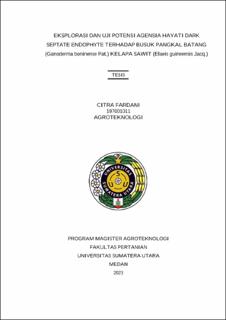Eksplorasi dan Uji Potensi Agensia Hayati Dark Septate Endophyte terhadap Busuk Pangkal Batang (Ganoderma boninense Pat.) Kelapa Sawit (Elaeis guineensis Jacq.)
Exploration and Potential Test as Biological Control Agents of Dark Septate Endophytes Against Basal Stem ROT (Ganoderma boninense Pat.) in Oil Palm (Elaeis guineensis Jacq.)

Date
2023Author
Fardani, Citra
Advisor(s)
Lisnawita
Siregar, Luthfi Aziz Mahmud
Metadata
Show full item recordAbstract
Basal stem rot caused by Ganoderma boninense is the most destructive disease in
oil palm plantations in Indonesia. Biological control with microbes as biological
control agents has been carried out. One of them is using Dark Septate Endophyte
(DSE), a group of endophytic fungi that have potential as plant growth promoting
in abiotic and biotic stress conditions. The aims of this experiment to obtain local
DSE fungi isolates of North Sumatra from Ganoderma endemic areas which have
the potential as biological control agents to control G. boninense. DSE exploration
was carried out in the area of moderate Ganoderma incidence (5-30%) in Galang
District, Deli Serdang Regency. The experiment was conducted at the Plant
Laboratory in Patumbak District, Deli Serdang Regency and the Plant Disease
Laboratory, Faculty of Agriculture, Universitas Sumatera Utara. The initial
selection of in vitro pathogenicity tests obtained 5 non pathogenic DSE isolates with
a germination percentage of 43%-60% isolates II 3A CM, Gelap A, II 4 CM,
II 3A CC, and Abu-abu. The antagonist test results of the DSE isolate against
G. boninense obtained a percentage of inhibition isolate I 3 A PK by 17.8% and
59.4% isolate Gelap A at observation 3 days after inoculation (DAI). Observation
of 5 DAI, the lowest inhibition of isolate I 3 A PH (22.3%) and the highest inhibition
is Gelap A isolate (74.1%). The inhibition of 7 DAI Gelap A isolate has reached
out 100%. Macroscopic observations were made of upper and lower surface colony
color, colony shape, elevation and colony edge with varying results. Microscopic
DSE isolates are short septate hyphae, melanin branched hyphae, chain
chlamydospores of isolates II 3 A CM. Short septate hyphae and melanin
chlamydospores, septate hyphae and chlamydospores hyaline with chains form of
isolate Gelap A. Multinucleate septate hyphae, uninucleate septate hyphae with
fusiform macroconidia 1-3 septate of isolate II 4 CM. Branched hyphae and septate
hyphae, melanin hyphae with intercalar chlamydospore of isolate II 3 A CC. Short
septate hyphae with terminal chlamydosora, hyaline hyphae with melanin
chlamydospore, and hyaline chlamydospores of isolate Abu-abu.
Collections
- Master Theses [429]
